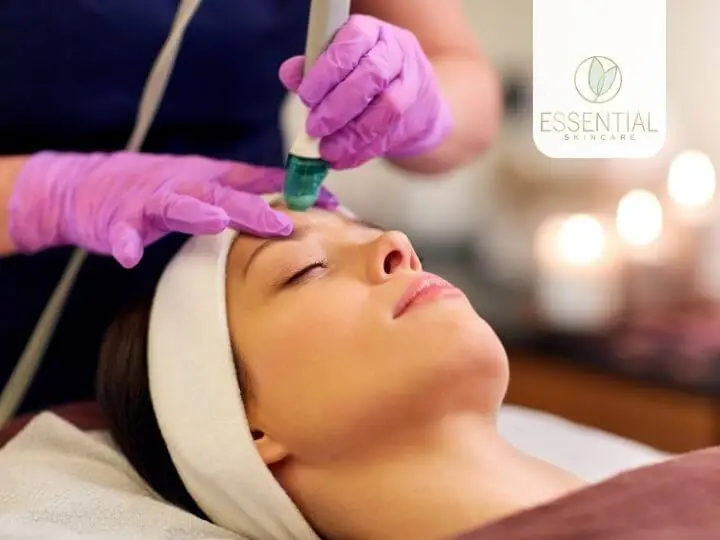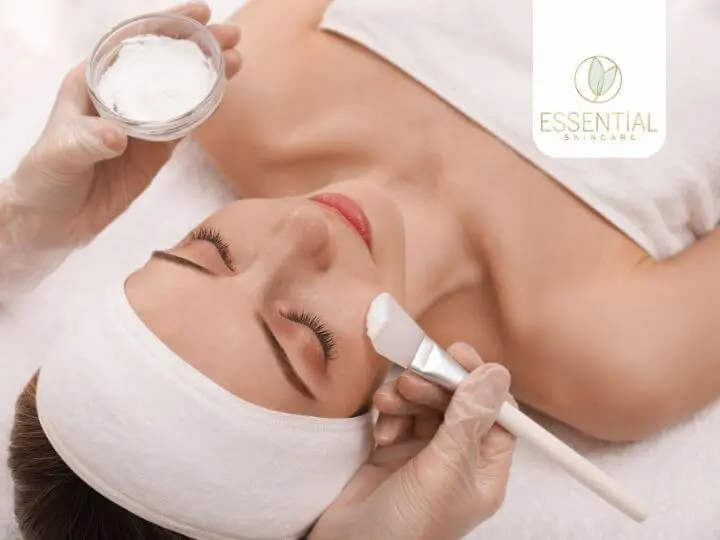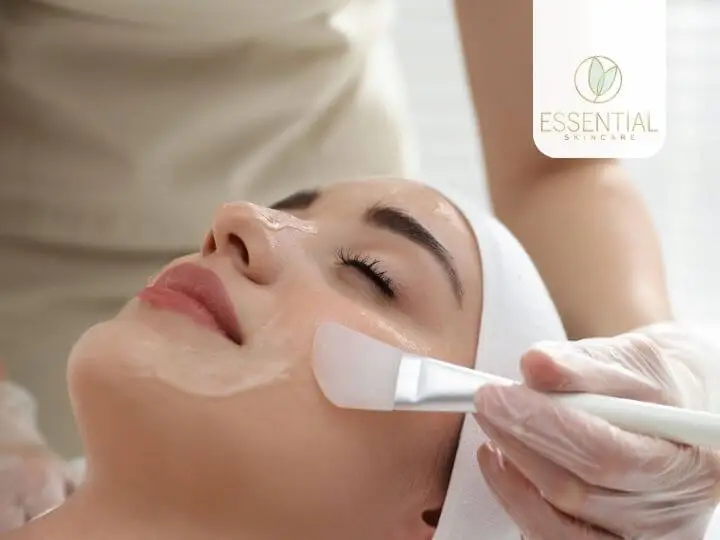Salicylic acid, an active beta hydroxy acid (BHA), combats acne with its unique ability to cleanse oil-filled pores deep within your skin. Its strength lies in its oil-dissolving capabilities, making it a choice weapon against pesky acne. This potent yet friendly acid not only loosens clogged pores but also smoothens your skin texture by reducing inflammation. When searching for salicylic acid-based products, zero in on items that have a 0.5% to 2% concentration – it’s this sweet spot where you’ll see optimal results without your skin feeling too dry or irritated. Essential Skincare specializes in chemical peels, offering a selection of effective, high-quality solutions featuring salicylic acid. Stick around to discover our selection of effective, high-quality acne solutions featuring salicylic acid.
Salicylic acid is a beta hydroxy acid that exfoliates the skin, helping to unclog pores and reduce inflammation. It is effective in treating acne by targeting excess oil and dead skin cells, leading to fewer breakouts and improved skin texture.
Working Mechanism of Salicylic Acid in Acne Treatment
So, how does salicylic acid actually work to help with acne? Well, it’s a beta hydroxy acid (BHA), making it oil-soluble. This unique feature allows it to penetrate the oil in your skin and exfoliate the clogged pores.
Let’s visualize your pores as tiny tunnels that can get clogged with dead skin cells, oils, and dirt—a perfect home for acne-causing bacteria. When salicylic acid is introduced, it works to dissolve these pore-clogging substances, clearing out the mess and preventing new blemishes from forming.
Additionally, salicylic acid has the remarkable ability to penetrate deeply into the pores due to its lipophilic nature. This deep penetration makes it particularly effective for treating acne-prone skin. It acts not only on the surface but delves deep into the source of the problem—the clogged pores.
Moreover, by promoting skin exfoliation and renewal, salicylic acid improves skin texture over time. The exfoliating action helps smooth out any rough patches caused by acne breakouts and leaves behind a fresher-looking complexion.
It’s evident that salicylic acid isn’t just a one-trick pony; it’s a multi-faceted ingredient that tackles acne from different angles, making it a valuable addition to your skincare routine.
With an understanding of how salicylic acid works wonders in combating acne, now we delve into deciphering how to spot effective skincare products designed to address this very concern.
Spotting Effective Acne Skincare Products with Salicylic Acid
When it comes to finding the right acne skincare products with salicylic acid, a few key considerations come into play. The concentration of salicylic acid in the product is crucial for its effectiveness without causing excessive dryness or irritation. Aim for products that contain a concentration of 0.5% to 2% of salicylic acid for optimal acne-fighting benefits.
It’s essential to strike a balance – too little salicylic acid won’t be as effective, while an excess can lead to skin irritation. Finding the right concentration for your skin type and the severity of your acne is vital to ensure it’s both helpful and gentle on your skin.
In addition to concentration, consider the type of product containing salicylic acid. Cleansers, toners, and spot treatments are popular options that effectively deliver salicylic acid to acne-prone areas of the skin. Look for gentle cleansers with added moisturizing properties to prevent excessive drying while effectively targeting breakouts. When it comes to spot treatments, a targeted application directly on blemishes may offer quicker relief from existing breakouts, making a quality spot treatment that contains salicylic acid a beneficial staple in your skincare routine.
Furthermore, ensuring that the products you choose contain ingredients known for their effectiveness and compatibility with various skin types is essential. For instance, at our skincare clinic, we prioritize offering a range of carefully selected salicylic acid-based products that have been praised for their effectiveness in combating acne while being gentle on the skin. Our clients have seen notable improvements in their skin condition with our expertly curated products.
Considering these factors can assist in finding the most effective and suitable acne skincare products with salicylic acid for your specific needs. Whether it’s a gentle cleanser, soothing toner, or targeted spot treatment, prioritizing product selection based on concentration and compatibility ensures optimal results and healthy, clear skin.
Assessing Side Effects: The Double-Edged Sword of Acne Treatment
Salicylic acid may be highly effective in combating acne, but like many good things in life, it comes with some trade-offs. Even though it can work wonders on your skin, it’s crucial to understand that it can also lead to mild side effects. These can include dryness, redness, or a stinging sensation, especially when used in higher concentrations or over a prolonged period.
When we talk about side effects, it’s essential to recognize that not everyone experiences these symptoms, and their severity can vary from person to person. For some individuals, salicylic acid may cause minimal discomfort, while others may find the side effects more bothersome. This makes it crucial to start with lower concentrations and observe how your skin reacts to the treatment over time.
In fact, conducting a patch test before using any salicylic acid product is a wise move. It helps to apply a small amount of the product to a discreet area of skin and monitor its effects over 24 hours. This way, you can assess if your skin tolerates the product well without experiencing any adverse reactions.
Another important consideration is the duration of use. Prolonged use of high concentrations of salicylic acid can exacerbate its potential side effects. If you’re new to using salicylic acid, consider starting with lower concentrations and gradually increasing it as your skin becomes accustomed to the treatment.
We must understand that while salicylic acid is an invaluable ally in the battle against acne, taking measures such as conducting patch tests and starting with lower concentrations are essential steps to minimize potential adverse reactions and ensure the best possible outcomes for your skin.
In navigating the complex terrain of acne treatment, understanding how to properly apply salicylic acid can make all the difference in achieving clearer and healthier skin. Join me as we delve into a comprehensive guide for optimizing the application of salicylic acid for effective acne treatment.
A Guide to Properly Apply Salicylic Acid for Acne Treatment
When it comes to applying salicylic acid for acne, the right technique can make all the difference. Here’s a breakdown of the steps you should follow to ensure you’re maximizing the benefits of this acne-fighting ingredient.
Cleansing: The First Step
Before applying salicylic acid, it’s important to start with a clean canvas—your skin. Using a gentle cleanser that is suitable for your skin type will help remove any dirt, oil, and impurities from your skin. This step ensures that there are no barriers preventing the salicylic acid from penetrating your skin effectively. Once your skin is clean and dry, you’re ready to move on to the next step—application.
Application: Precision is Key
When it comes to applying salicylic acid, precision is key. Using a small amount of the product, apply it directly to the affected areas. It’s important not to overuse the product, as this can lead to potential skin irritation and over-drying. If you’re unsure about how much product to use or where to apply it, consulting a skincare professional can provide valuable guidance tailored to your specific skin concerns and needs.
For example, if you’re dealing with localized breakouts, dabbing a small amount of salicylic acid onto individual blemishes can be more effective than applying it all over your face.
Moisturizing: Locking in Hydration
After applying salicylic acid, it’s essential to follow up with a non-comedogenic moisturizer. This helps keep your skin hydrated and balanced, mitigating any potential dryness that may occur as a result of using salicylic acid.
Keep in mind: While salicylic acid is excellent at targeting acne and exfoliating the skin, it can also potentially cause dryness in some individuals. A well-formulated moisturizer can counteract this effect, helping maintain the health and integrity of your skin.
In summary, by following these simple yet crucial steps—cleansing, precision application, and moisturizing—you can effectively harness the power of salicylic acid for treating acne while keeping your skin healthy and balanced.
Impeccable application techniques are essential for reaping the benefits of salicylic acid without compromising your skin’s health. Now, let’s scrutinize the precautions and measures crucial for safe usage of this potent acne-fighting ingredient.
Managing Risk: Usage Precautions for Salicylic Acid
While salicylic acid can work wonders for your skin, it’s crucial to take certain precautions when using it. This helps minimize the likelihood of experiencing adverse effects and ensures that you get the best results from your skincare routine.
Avoiding Sensitive Areas
It’s vital to steer clear of sensitive areas such as the eyes, mouth, and any open cuts or wounds on the skin when applying products containing salicylic acid. The skin in these areas is delicate and more prone to irritation, so it’s best to safeguard them from direct contact with salicylic acid to prevent discomfort or damage.
People often forget that the skin around the eyes and mouth is extremely delicate. Imagine rubbing salt in your eye – it really stings, right? That’s why you should be extra careful not to get any salicylic acid near these sensitive areas.
Monitoring for Excessive Side Effects
Keep a close eye on how your skin responds to salicylic acid. Some mild side effects like slight burning or tingling are normal, especially when starting. However, if you experience severe burning, redness, or signs of an allergic reaction such as itching, swelling, or hives, it’s important to discontinue use and seek professional advice immediately.
Keep in mind that everyone’s skin is different. What works wonders for one person could cause trouble for another. This makes monitoring your skin’s response even more essential.
Seeking Professional Advice
If you have pre-existing skin conditions or allergies, or if you’re unsure whether salicylic acid is right for you, consulting a skincare professional is highly recommended. They can provide personalized advice based on your specific needs and help you develop a safe and effective skincare regimen tailored to your skin type and any existing concerns.
Imagine going to a doctor when you’re not feeling well. You might not know what’s wrong exactly, but the doctor can find out and give you the right medicine to make you feel better. Similarly, a skincare professional can recommend a treatment that’s just right for your skin – something that wouldn’t cause any problems but would help clear up your acne.
In summary, taking precautions like avoiding contact with sensitive areas, closely monitoring for excessive side effects, and seeking professional advice as needed can help ensure that your experience with salicylic acid is safe and effective.
It may seem like a lot of steps at first but think about it this way: By taking these precautions now, you not only safeguard yourself from potential risks but also set the stage for clear, healthy skin in the long run.
With a firm grasp on safety measures while using salicylic acid for acne treatment, let’s now shift our focus to exploring alternative active ingredients for managing acne.

Exploring Alternatives: Other Active Ingredients for Acne Treatment
When it comes to treating acne, salicylic acid is just one piece of the puzzle. There are various other active ingredients that may be equally effective in addressing different types of acne concerns. Let’s explore some of these alternatives and how they work to provide relief.
Benzoyl Peroxide
Benzoyl peroxide is a common topical agent used in the treatment of acne. It works by reducing the amount of acne-causing bacteria on the skin, as well as helping to unclog pores and reduce inflammation. Unlike salicylic acid, which primarily targets exfoliation and clearing clogged pores, benzoyl peroxide has dual benefits—it kills bacteria and helps to clear pores, making it particularly useful for inflammatory acne such as red pimples and pustules.
It’s vital to note that benzoyl peroxide can sometimes cause dryness and irritation when used at high concentrations initially, so it’s often recommended to start with a lower concentration (2.5%) and gradually increase if needed. This makes it important for individuals with sensitive skin or those prone to dryness to test this ingredient cautiously.
Retinoids
Another effective option is retinoids. These are chemicals derived from vitamin A and are known for their ability to unclog pores and regulate skin cell turnover, which helps prevent acne formation. Retinoids can effectively target both comedonal (whiteheads and blackheads) and inflammatory acne, making them a versatile choice for many individuals dealing with different types of acne concerns.
However, retinoids can make the skin more sensitive to sunlight and may cause initial irritation when first starting treatment. As a result, it’s imperative to use sunscreen regularly and introduce retinoids gradually into your skincare routine.
Alpha Hydroxy Acids (AHAs)
Alpha hydroxy acids, including glycolic acid and lactic acid, are another group of ingredients found in many skincare products. They work by exfoliating the surface of the skin, helping to remove dead skin cells that can clog pores and lead to acne breakouts. AHAs also stimulate cell renewal and collagen production, resulting in an improved overall skin texture and appearance.
While AHAs can be effective in managing certain types of acne by preventing pore blockages and improving skin texture, it’s essential to note that they may cause initial dryness or irritation. As with all active ingredients in skincare, patch testing before regular use is recommended for individuals with sensitive or reactive skin.
At our skincare clinic, we understand that every individual’s skin is unique, and what works well for one person might not be suitable for another. That’s why we offer a comprehensive range of acne treatment solutions tailored to individual needs and preferences. Our experienced estheticians carefully assess each client’s skin type, existing conditions, and treatment goals to create personalized regimens that deliver results effectively while considering tolerability.
Exploring these alternative active ingredients provides valuable options that can deliver effective results in addressing different types of acne. It’s essential for individuals to understand their own skin type, preferences, tolerance levels, and any specific concerns they aim to address when selecting an acne treatment solution from this range.
For personalized expert advice on incorporating these active ingredients into your skincare routine or exploring other effective treatments for acne, visit us or call us at (419) 908-9301 today!










